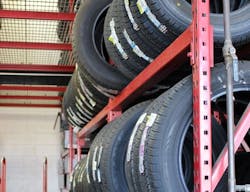Market Is Still Absorbing Price Increases
Last year, there were more than 40 publicly announced price increases by tire manufacturers. Fewer price hikes have been announced this year.
This doesn’t mean more increases aren’t on the way. But retail tire pricing expert JP Brooks says the market still needs to absorb recently announced price hikes. And that doesn’t happen overnight.
Brooks is the director of business development for Fitment Group, a Duluth, Minn.-based company that analyzes millions of passenger and light truck tire prices each week - pulled from independent tire dealerships, tire manufacturer-owned stores, big box retailers and e-commerce portals.
He says pricing will be somewhat difficult to predict during the rest of 2022 due to several factors. “The inflation rate for the U.S. has ticked down. We’re seeing a slight stabilization of inflation, but it’s too early to say that we’re moving in the right direction.”
Like many dealers, tire manufacturers, he believes, “are reacting to the data that keeps coming out in the marketplace. A good example is the volatility in the oil markets. Prices increased and then decreased fairly rapidly. I think with a lot of consumer goods, it’s di cult to have a long-term pricing strategy.”
Fitment Group tracks consumer tire pricing trends by tier. “Looking at price trend data — which are advertised prices — over the past seven months, the premium or what we call the ‘best’ category has increased in price the most” and has climbed 9.3%.
“If we look at what we call the opening price point tier, that’s been slightly lower at an 8.5% increase over the past seven months.
“And when we look at the mid-tier, those (products) trended at a 6.5% increase” during the same period.
“Recent economic data has shown the inflation rate to be 8.5% for the previous 12 months.”
Tire price hikes “are following along the lines of the other inlationary numbers we’re seeing. They’re following a consistent trend line.”
This also includes pricing in the nine U.S. regions - East North Central, East South Central, Middle Atlantic, Mountain, New England, Pacific, South Atlantic, West North Central and West South Central - that Fitment Group monitors.
“When we look at all of the regions put together, we do see a fairly consistent trend line over the past seven months. There weren’t a lot of spikes, even though the average price might be more in specific markets.”
One region of the country that has some “of the highest average tire prices right now is the Mountain Region,” which consists of Arizona, Colorado, Idaho, Montana, Nevada, New Mexico, Utah and Wyoming.
The East Coast and West Coast regions are the “most competitive” and volatile, according to Fitment Group research.
“When we compare the two coasts, we see that the West Coast trends higher in retail tire prices. California has some of the highest cost of living, from housing expenses to gas prices to even college tuition - even when compared to major cities on the East Coast.
“What we’re also looking at are tires coming in through the West Coast and then the transportation costs to move them over” to adjacent states or across the country.
These costs factor into the overall equation, says Brooks.
Looking ahead, he believes that the “rate of tire manufacturers publicly stating price increases will stay at as we wind down the rest of the year.
“It’s going to take some time for (recently implemented) increases to be presented as retail tire prices to the consumer.
“It takes some time for those increases” to be passed along to tire buyers, he says.
“If a company announces that a price increase will go into effect on Aug. 1, those prices aren’t instantly reflected in the market on Aug. 2. We could start feeling those in October or even November.”
